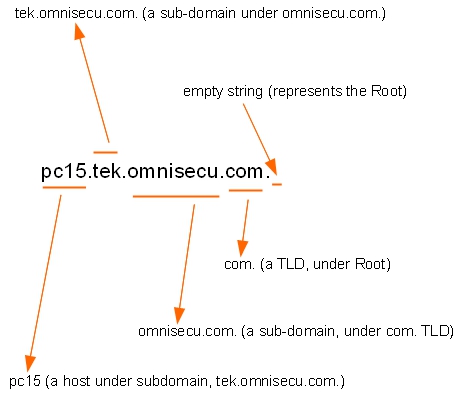Fully Qualified Domain Name (FQDN) and Partially Qualified Domain Name (PQDN)
Fully Qualified Domain Name (FQDN) of a host in the DNS namespace hierarchy consists of all the labels from the node, up to the root of the namespace, separated by periods ("."). Fully Qualified Domain Name (FQDN) must end with a empty string, which represnts the Root. Since there is no need to represent empty string, Fully Qualified Domain Name (FQDN) ends with a period (.). The trailing period (".") for the root domain is usually omitted in day to day use, but the DNS Resolver (Client) and DNS Servers must use it during actual DNS name queries..
Using Fully Qualified Domain Name (FQDN) , we can identify a host's position from the Root of the DNS namespace. An Fully Qualified Domain Name (FQDN) can unambiguously indicate the position of a host relative to the DNS Root.
Example of a Fully Qualified Domain Name (FQDN) is pc15.tek.omnisecu.com.
When you happen to see a Fully Qualified Domain Name (FQDN), you should understand its structure as explained below. Remember, a dot (".") is used to separate two labels inside a Fully Qualified Domain Name (FQDN).
Try to read it from right-most position, which represents the DNS Root.

Note: DNS Domain names can contain characters "a to z", "A to Z", "0 to 9", and "-" (hyphen) only. Other common characters are not allowed.
A Partially Qualified Domain Name (PQDN) is used to specify a portion of a domain name, normally the host portion of it. A Partially Qualified Domain Name (PQDN) starts with a host name, but it may not reach up to the root.
Example of Partially Qualified Domain Name (PQDN) pc15. Usually the computers will add the DNS suffix along with Partially Qualified Domain Name (PQDN) before sending a DNS query for name resolution.